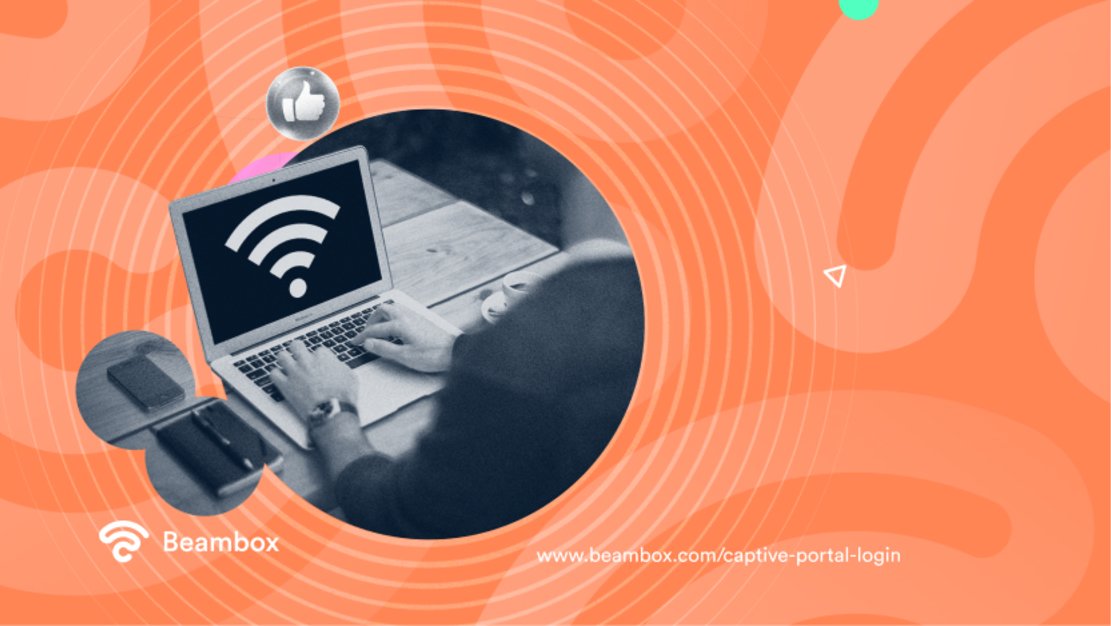A captive portal login is a surefire way to boost your marketing. A captive portal acts like a gate - demanding customer details before they access your Wi-Fi networks. It creates a deal for customers by popping up with a captive portal login window requesting details to proceed. After inputting their details, customers then receive internet access. Learning what captive portals are is vital when running a hospitality business.
If you have a venture like a coffee shop, customers expect Wi-Fi networks. You may as well use captive portals to improve your marketing and wireless security. Adding a captive portal is a fantastic, low-cost way to boost your business. Ready to dive? This guide has everything you need to know about captive portals.
We’ll cover what they are and how to set them up - no matter your device type. Learning about captive portals is essential to have a sense of direction. It’s so useful that you want all the juicy details to set it up quickly. And with that said, let’s get started.
What Is a Captive Portal Login?

So, what is a captive portal login? A captive portal is a login window when customers try to access your Wi-Fi. The pop-up appears when customers select your WI-Fi network in their settings. And instead of just letting people join your network immediately, it adds an extra layer of security. People have to input specific details to join. You submit these detail in a form with prompts about what they should add. Captive portal logins take around 30 seconds to fill in (sometimes even less). However, this tool can drastically boost your business.
Firstly a captive portal login adds to your wireless security. With a compulsory screening stage before login, you can screen and log who joins your network. For instance, if you don’t want people using your network for specific things, add a terms and conditions agreement. You can get customers to agree to set rules - like not using Wi-Fi to stream music in a public place. You can also verify whether devices joining are malicious with requirements like inputting a valid email address.
Secondly, you can use a captive portal to collect information for marketing. The login forms could collect demographic details like age, name, and personal preferences. It can also request contact details like email addresses for email marketing lists. A well-executed captive portal is a tool to collect and utilize details for a marketing campaign. It is incredible how much information people will provide in exchange for Wi-Fi.
How To Enable a Captive Portal Login
The question of how to enable a captive portal login is a good one. It does depend on your Wi-Fi WAP and any software that you purchase. Each WAP and software is different, but some general rules do apply. You must log onto its management settings online for a WAP (Wireless Access Point). Wizard Setup is a dream tool for this process.
If you need help accessing your specific device’s settings online, contact its help services. The company experts will know the exact steps for your particular device. However, if you can navigate to your SSID profile, these are the basic steps when enabling a portal login:
- Open up settings in an SSID profile.
- Select ‘Enable Captive Portal.’
- Save your changes and test the portal by attempting to join Wi-Fi from an unfamiliar device.
Do you need to work? Check these top solutions. One of the most common setups mistakes is failing to save changes - ensure you complete this step. If you’ve completed all these steps and the captive portal isn’t enabled, reboot the WAP. After rebooting, try to join again off an unfamiliar device. And if you still need help, ask the respective tech companies for your WAP and captive portal software directly.
How To Use a Captive Portal Login: Android Devices
Android devices work almost identically with a captive portal login to Apple devices. When you join a Wi-Fi network with a login system, a notification takes you to the captive portal. However, there are a few differences.
One thing to note is a lot of recent work to make using captive portal logins for Android users. There have been many issues with web pages needing fixing. With this common issue, Android users have to ‘go looking for the captive portal’ on Google. This solution involves typing things into the address bar in Google - like random search queries - to prompt a login notification. This issue arises from your Android device failing to detect the captive portall.
Now, though, Android has hopefully alleviated that issue. New Android devices come with high-quality captive portal detection and a standard probe address. The probe address is com—Android—captive portal login in the address bar.
If you need help with your Android device and captive portals, the best fix is to contact Android support services.
How To Use a Captive Portal on Apple Devices
A captive portal login using an Apple device is similar to using captive portals on an Android device. When working correctly, you get an immediate notification when you click on the Wi-Fi network. This notification offers a link to the login web page - allowing you to input your details and start browsing.
If this doesn’t appear immediately, there are a few different steps. It is relatively uncommon for captive portals not to open on your Apple device. But don’t worry if it does happen; these solutions are quick and easy.
The first solution Apple users should try is clicking on the I symbol to open more network information. You can then request to join the network by clicking the join network button. This joining method differs from the standard request and can sometimes jog the captive portal quicker. As an extra step, ensure that auto-join is on when you open these settings.
If that does not work, Apple devices also have a URL that can force open a captive portal as a last resort. Type http://captive.apple.com/hotspot-detect.html into your browser, and the portal should force open immediately.
Of course, if you still need help with your Apple device and captive portals, contact Apple customer services directly. Customer services can give you instant and expert advice on more complex issues.
Is Captive Portal Login Spyware?
Captive portal login pages are not spyware. The captive portal system provides extra security that provides a safer, fairer way for customers to use a business’ internet. The portal requests set details from customers that allow companies to further their marketing. For instance, they are using customers’ ages to understand age demographics better and requesting their email addresses to add to an email marketing campaign.
However, Wi-Fi network owners can see specific information about how customers use their internet connection. While this isn’t malicious and doesn’t compromise valuable data, it’s essential to understand this for privacy. The business Wi-Fi owner can see all the internet browsing details for customers. Browsing details show up in a log, including what pages customers visit and how long they stay there. You can access this information in your router’s admin panel as a business owner. If you know how your customers use your Wi-Fi network, mention this in your captive portal. You could add a terms and conditions agreement banning certain online activities. Or add a quick disclosure note about browsing privacy.
From a customer perspective, captive portal networks are safer from spyware than open networks. Use a public network with no captive login with caution - it is a red flag for cyberattacks. These networks are more vulnerable to security breaches, and threats like hackers may compromise your device if you join one.
As a side note, spyware should be at the back of your mind when using a captive portal login. Always take care when joining unfamiliar networks - even captive portal ones. We suggest avoiding joining the network if the requested details include bank details or personal device information. You should also update your device with the latest, high-quality anti-virus software.
Final Thoughts: Setting up Your Captive Portal Today

A captive portal login is one of the easiest yet most effective ways to boost your business. Setting up a captive portal is a brilliant option if you want to take action today. You can quickly purchase low-cost software online. Captive portals are incredible marketing tools and security buffers for your Wi-Fi network. Plus, captive portals are simple enough to set up that you have to seek expert help unless you want to. Captive portals are something you can tackle yourself for your business.
Your first move should be finding software. And then, once you’ve confirmed that, you can edit and adjust the login page to suit your business best. You may be desperate for email addresses for your email marketing subscriptions. Or you may want demographic details like the age range of customers. Whatever details you wish to collect, editing the standard login page should take an hour or so. There are plenty of captive portal templates online.
Do you need direction? Contact us at Beambox if you need assistance setting up your captive portal login today.
You can outsource the task to us, getting the ball rolling immediately today. Beambox has the best all-in-one Wi-Fi marketing platform. We leverage a dynamic approach to connect, capture, and keep more customers. Start your Beambox free trial today, and let us help you maximize your business potential.
Get Started With Free WiFi Marketing
Beambox helps businesses like yours grow with data capture, marketing automation and reputation management.
Sign up for 30 days free